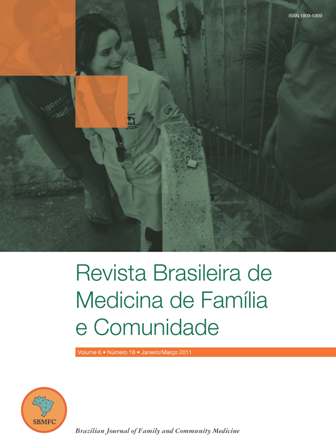Care articulation by the Family Physician: improvement in the quality of life in terminal patient
DOI:
https://doi.org/10.5712/rbmfc6(18)96Keywords:
Primary Health Care, Delivery of Health Care, Integrated, Continuity of Patient CareAbstract
Introduction: According to the definition of the role of the Family Physician (FP) presented in the statement of the European Wonca 2002, one of her/his features is the ability of coordination of care, and management of the interface with other specialties. However, there are serious problems of coordination between the levels of assistance, as showed by the discontinuity of care when patients are hospitalized. With the aim of raising awareness and analyze a particular case of interface between the Primary Health Care (PHC) and Hospital, and how important is the success of a good collaboration, this case is reported. Description of case: Male, 50 years old, caucasian race, inserted into a nuclear family in the stage VI Duvall’s cycle. A gastric adenocarcinoma by his FP was diagnosed at 49 years old. The patient was referenced to urgent consultation of general surgery. With various surgical complications he had a long internment. A poorly differentiated and infiltrating gastric carcinoma at the stage T3 N1 Mx, with poor prognosis, was confirmed. There was serious lack of interface and gaps in information between the hospital and the PHC. There was a bad care of the patient, with worsening of his condition. At the insistence of the FP, the articulation becomes effective and there was improved in quality of care and of the general condition of the patient. Conclusion: A proper interface and coordination of care contributed to better quality of life and satisfaction of patients, with positive repercussions for their families, to health professionals involved and to the National Health Service. The completion of the FP core competencies will only be possible when his/her proper function will be recognized and known by all the other health professionals.
Note: The speciality physician denomination changes according to the country; in Brazil, it receives the name of Medicina de Família e Comunidade. In Portugal, country of the author of this paper, this speciality is named Medicina Geral e Familiar. Other terms or expressions of this paper were kept in its original language.
Downloads
Metrics
References
World Organization of National Colleges, Academies and Academic Associations of General Practitioners/Family Physicians (Wonca) [Internet]. Definição Europeia de Medicina Geral e Familiar, WONCA EUROPA 2002 [acedido em 2008 Dez 1]. Disponível em: http://www.apmcg.pt/files/54/documentos/2007060115471793311.pdf
Núñez RT, Lorenzo IV, Vázques Navarrete ML. La coordinación entre niveles asistenciales: una sistematización de sus instrumentos y medidas. Gac Sanit. 2006; 20(6): 485-95. DOI: https://doi.org/10.1157/13096516
Stille CJ, Jerant A, Bell D, Meltzer D, Elmore JG. coordinating care across diseases, settings, and clinicians: a key role for the generalist in practice. Ann Intern Med. 2005; 142: 700-08. DOI: https://doi.org/10.7326/0003-4819-142-8-200504190-00038
Mitchell GK, Tieman JJ, Shelby-James TM. Multidisciplinary care planning and teamwork in primary care. Med J Aust. 2008; 188(8 Suppl): S61-4. DOI: https://doi.org/10.5694/j.1326-5377.2008.tb01747.x
Powell Davies G, Williams AM, Larsen K, Perkins D, Roland M, Harris MF. Coordinating primary health care: an analysis of the outcomes of a systematic review. Med J Aust. 2008; 188 (8 Suppl): S65-8. DOI: https://doi.org/10.5694/j.1326-5377.2008.tb01748.x
Caeiro R. Registos Clínicos em Medicina Familiar. Instituto de Clínica Geral da Zona Sul. Ministério da Saúde: Direcção-Geral dos Cuidados de Saúde Primários; 1999.
Graffar, M. Une méthode de classification sociale d’échantillons de population. Courier. 1956. v. 6. p. 455.
Gérvas J y Seminario de Innovación en Atención Primaria 2006. La polivalencia clínica médica y el contexto social y organizativo. Rev Adm Sanit. 2008; 6(2): 357-66.
Arvantes J [internet]. Q&A With Primary Care Aficionado: Barbara Starfield, M.D. Focuses on Primary Care and Health Care Reform. Aafp news now; 2009 [acedido em 2009 Set 3]. Disponível em: http://www.aafp.org/online/en/home/publications/news/news-now/professionalissues/20090902starfield-q-a.html
Magrinyà AP. Como organizar las relaciones externas del equipo de Atencíon Primaria? In: Semfyc ediciones. Guía de Actuación en Atención Primaria. 3ª. Edición. Barcelona; 2006. p.1214-15.
Downloads
Published
How to Cite
Issue
Section
License
By submitting a manuscript to the RBMFC, authors retain ownership of the copyright in the article, and authorize RBMFC to publish that manuscript under the Creative Commons Attribution 4.0 license and identify itself as the vehicle of its original publication.















